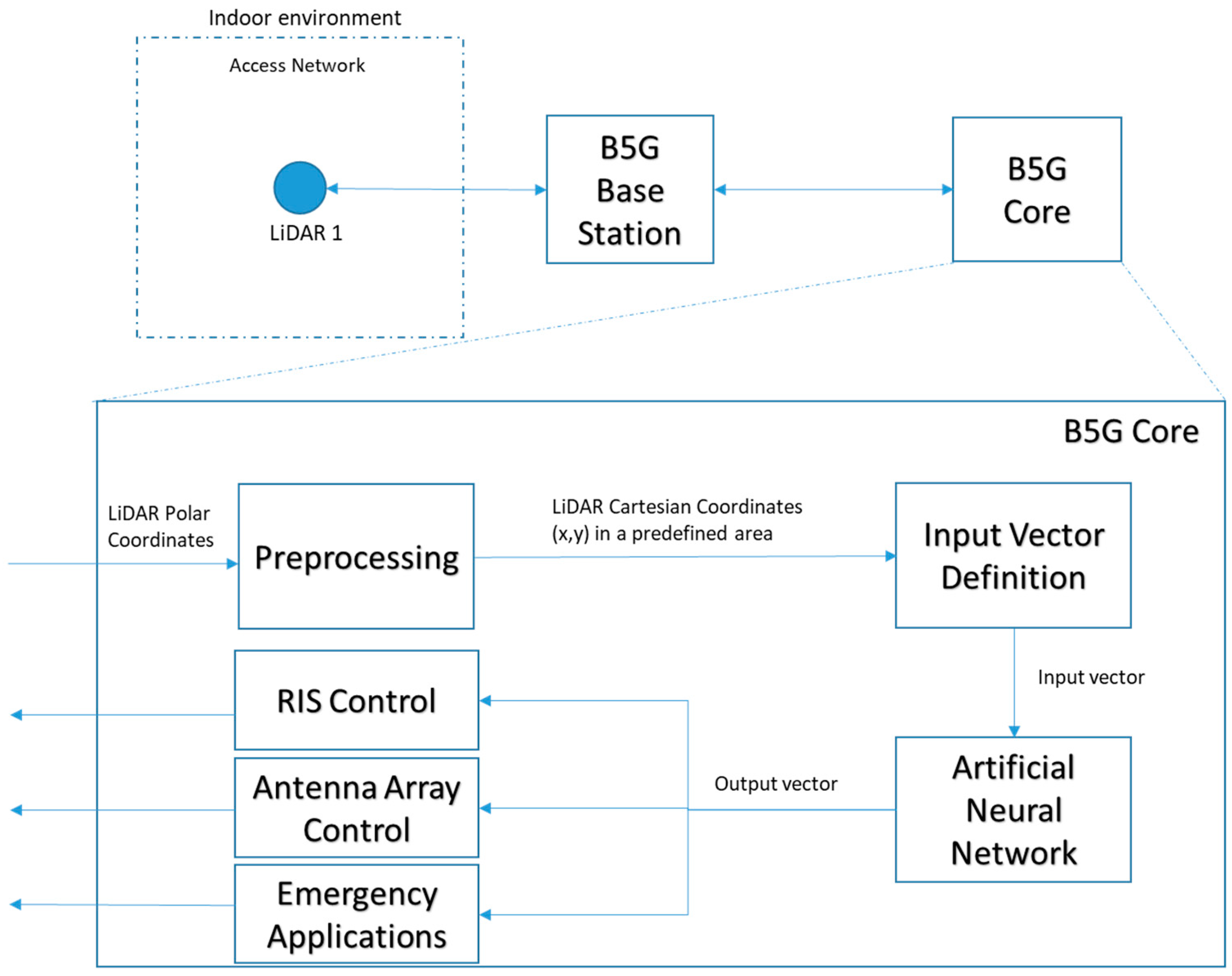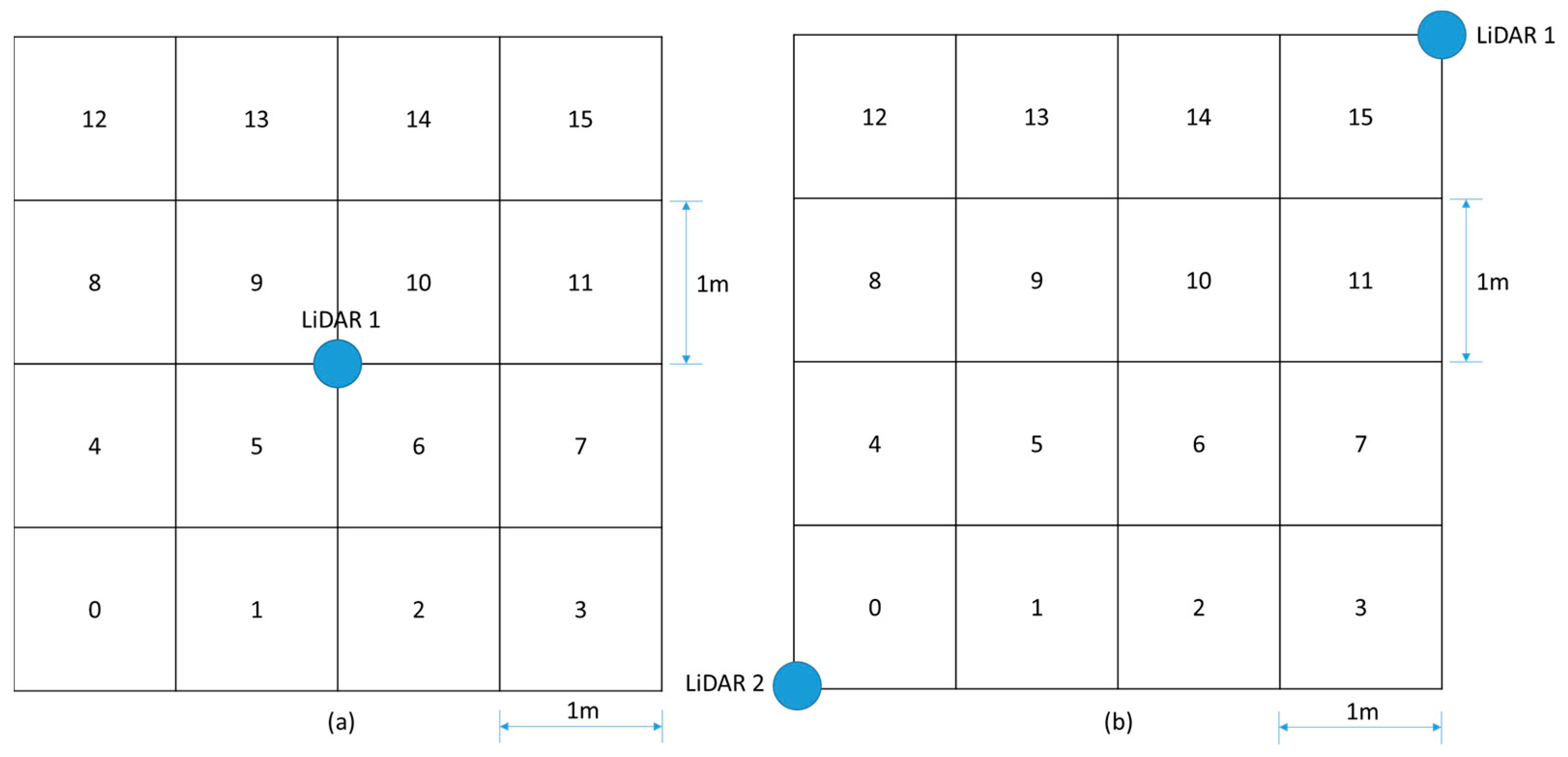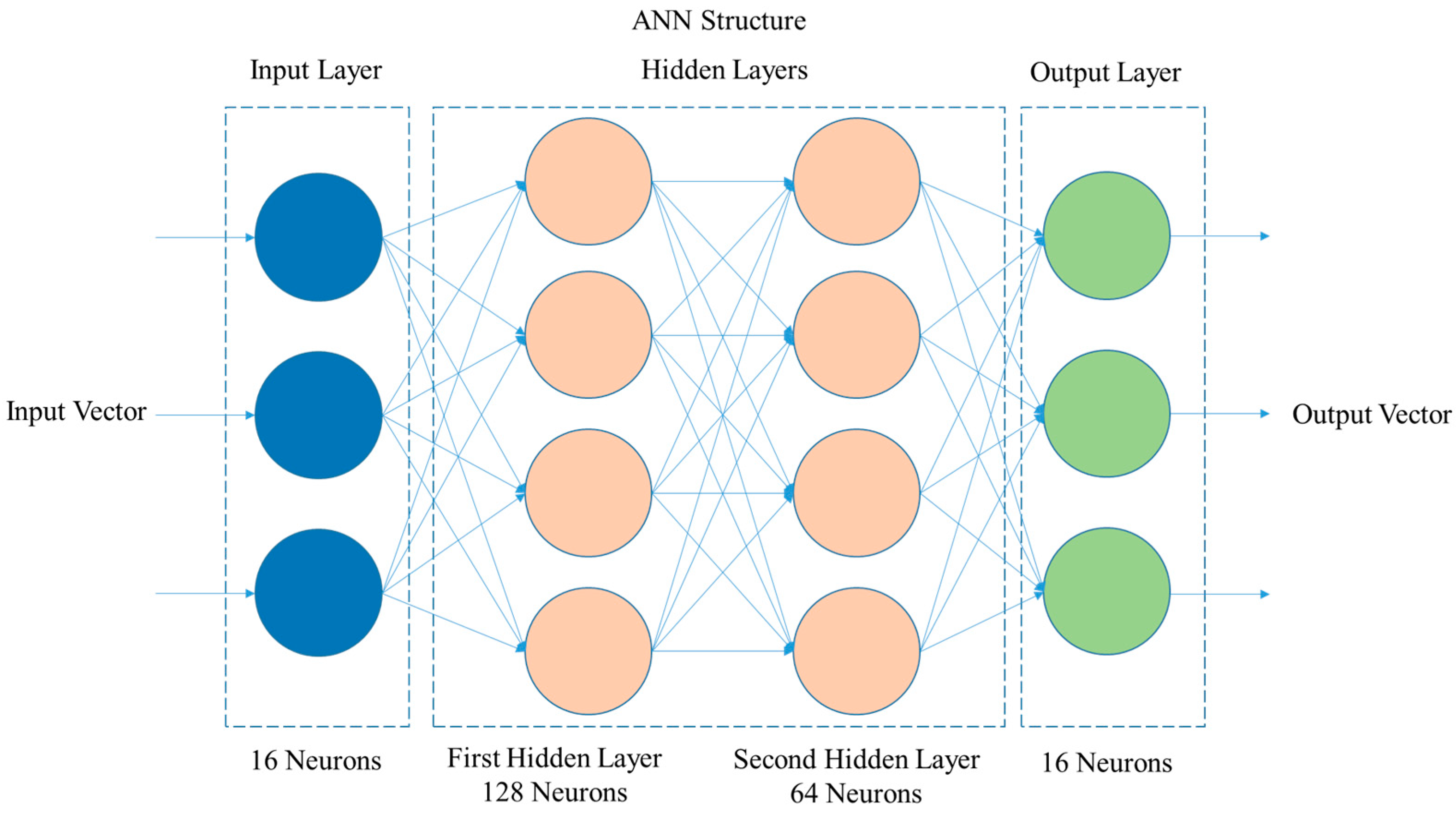ANN-Based LiDAR Positioning System for B5G
Abstract
:1. Introduction
2. Materials and Methods
2.1. ANN-Based 2D-LiDAR for Positioning B5G Applications
2.2. The 2D-LiDAR
2.3. LiDAR Data Processing
2.4. Tests in Indoor Environments
2.5. ANN—Artificial Neural Network
2.5.1. Input and Output Structures and Labels
2.5.2. Neural Network Architecture
- First Hidden Layer: This layer has 128 neurons, a choice that reflects the balance between computational capacity and sufficient complexity to capture a wide range of patterns in the data. The ReLU activation function is used here for its effectiveness in adding non-linearity to the model, allowing the network to learn complex and varied patterns in the input data.
- Second Hidden Layer: Contains 64 neurons, following the logic of a “funnel” architecture, where the progressive reduction in the number of neurons aids in consolidating learned patterns and reducing the complexity of the model, facilitating generalization to new data. The ReLU function continues to be used to maintain non-linearity.
- Output Layer: Composed of a number of neurons equal to the number of quadrants in the grid, 16, this layer uses the sigmoid activation function. This choice is ideal for binary classification, transforming the network outputs into probabilities that range from 0 to 1, interpreted as the probability of the presence of the reading in each specific quadrant.
2.5.3. Training and Evaluation Process
3. Results
3.1. Test Scenario 1
3.2. Test Scenario 2
4. Discussion
4.1. Scenario Comparison: Single vs. Dual LiDAR Configuration
4.2. Impact of Data Combination in Dual LiDAR Configuration
4.3. Comparative Analysis of Data Integration Strategies
4.4. Final Comments
5. Conclusions and Future Works
Author Contributions
Funding
Data Availability Statement
Acknowledgments
Conflicts of Interest
References
- De Vriendt, J.; Laine, P.; Lerouge, C.; Xu, X. Mobile network evolution: A revolution on the move. IEEE Commun. Mag. 2002, 40, 104–111. [Google Scholar] [CrossRef]
- Dahlman, E.; Gudmundson, B.; Nilsson, M.; Skold, A. UMTS/IMT-2000 based on wideband CDMA. IEEE Commun. Mag. 1998, 36, 70–80. [Google Scholar] [CrossRef]
- Astely, D.; Dahlman, E.; Furuskär, A.; Jading, Y.; Lindström, M.; Parkvall, S. LTE: The evolution of mobile broadband. IEEE Commun. Mag. 2009, 47, 44–51. [Google Scholar] [CrossRef]
- Popovski, P.; Trillingsgaard, K.F.; Simeone, O.; Durisi, G. 5G Wireless Network Slicing for eMBB, URLLC, and mMTC: A Communication-Theoretic View. IEEE Access 2018, 6, 55765–55779. [Google Scholar] [CrossRef]
- Liyanage, M.; Gurtov, A.; Ylianttila, M. Software Defined Mobile Networks (SDMN): Beyond LTE Network Architecture; Wiley: Hoboken, NJ, USA, 2015. [Google Scholar]
- Wijethilaka, S.; Liyanage, M. Realizing Internet of Things with Network Slicing: Opportunities and Challenges. In Proceedings of the 2021 IEEE 18th Annual Consumer Communications & Networking Conference (CCNC), Las Vegas, NV, USA, 9–12 January 2021; pp. 1–6. [Google Scholar] [CrossRef]
- Siriwardhana, Y.; De Alwis, C.; Gür, G.; Ylianttila, M.; Liyanage, M. The Fight Against the COVID-19 Pandemic with 5G Technologies. IEEE Eng. Manag. Rev. 2020, 48, 72–84. [Google Scholar] [CrossRef]
- Andrews, J.G.; Buzzi, S.; Choi, W.; Hanly, S.V.; Lozano, A. What Will 5G Be? IEEE J. Sel. Areas Commun. 2014, 32, 1065–1082. [Google Scholar] [CrossRef]
- Fitzek, F.H.P.; Seeling, P. Why we should not talk about 6G. arXiv 2020, arXiv:2003.02079. [Google Scholar] [CrossRef]
- Li, R. A Blueprint of Technology, Applications and Market Drivers towards the Year 2030 and Beyond; ITU-T FG-NET-2030; ITU: Geneva, Switzerland, 2019. [Google Scholar]
- ITU. Future technology trends for the evolution of IMT towards 2030 and beyond. In Liaison Statement, ITU-R Working Party 5D; ITU: Geneva, Switzerland, 2020. [Google Scholar]
- Saad, W.; Bennis, M.; Chen, M. A Vision of 6G Wireless Systems: Applications, Trends, Technologies, and Open Research Problems. IEEE Netw. 2020, 34, 134–142. [Google Scholar] [CrossRef]
- Fang, F.; Xu, Y.; Pham, Q.-V.; Ding, Z. Energy-Efficient Design of IRS-NOMA Networks. IEEE Trans. Veh. Technol. 2020, 69, 14088–14092. [Google Scholar] [CrossRef]
- Lu, Y.; Zheng, X. 6G: A survey on technologies, scenarios, challenges, and the related issues. J. Ind. Inf. Integr. 2020, 19, 100158. [Google Scholar] [CrossRef]
- Liu, Y.; Yuan, X.; Xiong, Z.; Kang, J.; Wang, X.; Niyato, D. Federated learning for 6G communications: Challenges, methods, and future directions. China Commun. 2020, 17, 105–118. [Google Scholar] [CrossRef]
- Junglas, I.A.; Watson, R.T. Location-based services. Commun. ACM 2008, 51, 65–69. [Google Scholar] [CrossRef]
- Bush, S.F. A simple metric for ad hoc network adaptation. IEEE J. Sel. Areas Commun. 2005, 23, 2272–2287. [Google Scholar] [CrossRef]
- Wang, G.; Chen, H.; Li, Y.; Jin, M. On received-signal-strength based localization with unknown transmit power and path loss exponent. IEEE Wirel. Commun. Lett. 2012, 1, 536–539. [Google Scholar] [CrossRef]
- Xiong, J.; Jamieson, K. Arraytrack: A fine-grained indoor location system. In Proceedings of the 10th USENIX Symposium on Networked Systems Design and Implementation, NSDI 2013, Lombard, IL, USA, 2–5 April 2013; pp. 71–84. [Google Scholar]
- Zhang, R.; Hoflinger, F.; Reindl, L. TDOA-based localization using interacting multiple model estimator and ultrasonic transmitter/receiver. IEEE Trans. Instrum. Meas. 2013, 62, 2205–2214. [Google Scholar] [CrossRef]
- Zheng, Y.; Sheng, M.; Liu, J.; Li, J. Exploiting AoA estimation Accuracy for indoor localization: A weighted AoA-based approach. IEEE Wirel. Commun. Lett. 2019, 8, 65–68. [Google Scholar] [CrossRef]
- Yang, Z.; Zhou, Z.; Liu, Y. From RSSI to CSI: Indoor localization via channel response. ACM Comput. Surv. 2013, 46, 25. [Google Scholar] [CrossRef]
- Li, Q.; Li, W.; Sun, W.; Li, J.; Liu, Z. Fingerprint and assistant nodes based Wi-Fi localization in complex indoor environment. IEEE Access 2016, 4, 2993–3004. [Google Scholar] [CrossRef]
- Luo, R.C.; Hsiao, T.-J. Indoor localization system based on hybrid Wi-Fi/BLE and hierarchical topological fingerprinting approach. IEEE Trans. Veh. Technol. 2019, 68, 10791–10806. [Google Scholar] [CrossRef]
- Costanzo, A.; Dardari, D.; Aleksandravicius, J.; Decarli, N.; Del Prete, M.; Fabbri, D.; Fantuzzi, M.; Guerra, A.; Masotti, D.; Pizzotti, M.; et al. Energy autonomous UWB localization. IEEE J. Radio Freq. Identif. 2017, 1, 228–244. [Google Scholar] [CrossRef]
- Liu, M.; Wang, H.; Yang, Y.; Zhang, Y.; Ma, L.; Wang, N. RFID 3-D indoor localization for tag and tag-free target based on interference. IEEE Trans. Instrum. Meas. 2019, 68, 3718–3732. [Google Scholar] [CrossRef]
- Brena, R.F.; Garcia-Vázquez, J.P.; Galván-Tejada, C.E.; Muñoz-Rodriguez, D.; Vargas-Rosales, C.; Fangmeyer, J. Evolution of indoor positioning technologies: A survey. J. Sens. 2017, 2017, 2630413. [Google Scholar] [CrossRef]
- Zafari, F.; Gkelias, A.; Leung, K.K. A survey of indoor localization systems and technologies. IEEE Commun. Surveys Tuts. 2019, 21, 2568–2599. [Google Scholar] [CrossRef]
- Nessa, A.; Adhikari, B.; Hussain, F.; Fernando, X.N. A Survey of Machine Learning for Indoor Positioning. IEEE Access 2020, 8, 214945–214965. [Google Scholar] [CrossRef]
- Guo, X.; Ansari, N.; Hu, F.; Shao, Y.; Elikplim, N.R.; Li, L. A survey on fusion-based indoor positioning. IEEE Commun. Surveys Tuts. 2020, 22, 566–594. [Google Scholar] [CrossRef]
- Guo, X.; Zhu, S.; Li, L.; Hu, F.; Ansari, N. Accurate WiFi localization by unsupervised fusion of extended candidate location set. IEEE Int. Things J. 2019, 6, 2476–2485. [Google Scholar] [CrossRef]
- Liu, K.; Zhang, H.; Ng, J.K.-Y.; Xia, Y.; Feng, L.; Lee, V.C.S.; Son, S.H. Toward low-overhead fingerprint-based indoor localization via transfer learning: Design, implementation, and evaluation. IEEE Trans. Ind. Informat. 2018, 14, 898–908. [Google Scholar] [CrossRef]
- Wild, T.; Braun, V.; Viswanathan, H. Joint Design of Communication and Sensing for Beyond 5G and 6G Systems. IEEE Access 2021, 9, 30845–30857. [Google Scholar] [CrossRef]
- Qian, J.; Chen, K.; Chen, Q.; Yang, Y.; Zhang, J.; Chen, S. Robust Visual-Lidar Simultaneous Localization and Mapping System for UAV. IEEE Geosci. Remote Sens. Lett. 2022, 19, 6502105. [Google Scholar] [CrossRef]
- Chan, S.-H.; Wu, P.-T.; Fu, L.-C. Robust 2D Indoor Localization Through Laser SLAM and Visual SLAM Fusion. In Proceedings of the 2018 IEEE International Conference on Systems, Man, and Cybernetics (SMC), Miyazaki, Japan, 7–10 October 2018; pp. 1263–1268. [Google Scholar] [CrossRef]
- Zhao, S.; Zhang, H.; Wang, P.; Nogueira, L.; Scherer, S. Super Odometry: IMU-centric LiDAR-Visual-Inertial Estimator for Challenging Environments. In Proceedings of the 2021 IEEE/RSJ International Conference on Intelligent Robots and Systems (IROS), Prague, Czech Republic, 27 September–1 October 2021; pp. 8729–8736. [Google Scholar] [CrossRef]
- Pierzchała, M.; Giguère, P.; Astrup, R. Mapping Forests Using an Unmanned Ground Vehicle with 3D LiDAR and Graph-SLAM. Comput. Electron. Agric. 2018, 145, 217–225. [Google Scholar] [CrossRef]
- Zhu, Q.; Chen, L.; Li, Q.; Li, M.; Nüchter, A.; Wang, J. 3D LIDAR Point Cloud Based Intersection Recognition for Autonomous Driving. In Proceedings of the 2012 IEEE Intelligent Vehicles Symposium, Madrid, Spain, 3–7 June 2012; pp. 456–461. [Google Scholar]
- VanVoorst, B.R.; Hackett, M.; Strayhorn, C.; Norfleet, J.; Honold, E.; Walczak, N.; Schewe, J. Fusion of LIDAR and Video Cameras to Augment Medical Training and Assessment. In Proceedings of the 2015 IEEE International Conference on Multisensor Fusion and Integration for Intelligent Systems (MFI), San Diego, CA, USA, 14–16 September 2015; pp. 345–350. [Google Scholar] [CrossRef]
- Torres, P.; Marques, H.; Marques, P. Pedestrian Detection with LiDAR Technology in Smart-City Deployments–Challenges and Recommendations. Computers 2023, 12, 65. [Google Scholar] [CrossRef]
- Wang, Z.; Menenti, M. Challenges and Opportunities in Lidar Remote Sensing. Front. Earth Sci. 2021, 9, 713129. [Google Scholar] [CrossRef]
- Ibrahim, M.; Akhtar, N.; Jalwana, M.A.A.K.; Wise, M.; Mian, A. High Definition LiDAR Mapping of Perth CBD. In Proceedings of the 2021 Digital Image Computing: Techniques and Applications (DICTA), Gold Coast, Australia, 29 November–1 December 2021; pp. 01–08. [Google Scholar] [CrossRef]
- Lou, L.; Li, Y.; Zhang, Q.; Wei, H. SLAM and 3D Semantic Reconstruction Based on the Fusion of Lidar and Monocular Vision. Sensors 2023, 23, 1502. [Google Scholar] [CrossRef] [PubMed]
- Zou, Q.; Sun, Q.; Chen, L.; Nie, B.; Li, Q. A Comparative Analysis of LiDAR SLAM-Based Indoor Navigation for Autonomous Vehicles. IEEE Trans. Intell. Transp. Syst. 2022, 23, 6907–6921. [Google Scholar] [CrossRef]
- Azim, A.; Aycard, O. Detection, Classification and Tracking of Moving Objects in a 3D Environment. In Proceedings of the 2012 IEEE Intelligent Vehicles Symposium, Madrid, Spain, 3–7 June 2012; pp. 802–807. [Google Scholar] [CrossRef]
- Kiran, R.; Roldao, L.; Irastorza, B.; Verastegui, R.; Suss, S.; Yogamani, S.; Talpaert, V.; Lepoutre, A.; Trehard, G. Real-time Dynamic Object Detection for Autonomous Driving Using Prior 3D-Maps. In Proceedings of the European Conference on Computer Vision (ECCV) Workshops, Munich, Germany, 8–14 September 2018. [Google Scholar]
- Vu, T.-D.; Aycard, O. Laser-Based Detection and Tracking Moving Objects Using Data-Driven Markov Chain Monte Carlo. In Proceedings of the 2009 IEEE International Conference on Robotics and Automation, Kobe, Japan, 12–17 May 2009; pp. 3800–3806. [Google Scholar]
- Xhafa, A.; Del Peral-Rosado, J.A.; López-Salcedo, J.A.; Seco-Granados, G. Evaluation of 5G Positioning Performance Based on UTDoA, AoA and Base-Station Selective Exclusion. Sensors 2022, 22, 101. [Google Scholar] [CrossRef] [PubMed]
- Sohn, K.; Bernardi, A.; Neiroukh, O.R. Effects of Input Resolution on LIDAR Pedestrian Localization using Deep Learning. In Proceedings of the 2021 International Conference on Electronics, Information, and Communication (ICEIC), Jeju, Republic of Korea, 31 January 2021–3 February 2021; pp. 1–4. [Google Scholar] [CrossRef]
- Karfakis, P.T.; Couceiro, M.S.; Portugal, D. NR5G-SAM: A SLAM Framework for Field Robot Applications Based on 5G New Radio. Sensors 2023, 23, 5354. [Google Scholar] [CrossRef]
- Rinchi, O.; Alsharoa, A.; Shatnawi, I. Deep-learning-based Accurate Beamforming Prediction Using LiDAR-assisted Network. In Proceedings of the 2023 IEEE 34th Annual International Symposium on Personal, Indoor and Mobile Radio Communications (PIMRC), Toronto, ON, Canada, 5–8 September 2023; pp. 1–5. [Google Scholar] [CrossRef]
- Chen, R.; Liu, M.; Hui, Y.; Cheng, N.; Li, J. Reconfigurable Intelligent Surfaces for 6G IoT Wireless Positioning: A Contemporary Survey. IEEE Int. Things J. 2022, 9, 23570–23582. [Google Scholar] [CrossRef]
- Slamtec. Slamtec RPLiDAR A1 [Internet]. Available online: https://www.slamtec.ai/product/slamtec-rplidar-a1/ (accessed on 9 March 2024).
- Heydarian, M.; Doyle, T.E.; Samavi, R. MLCM: Multi-Label Confusion Matrix. IEEE Access 2022, 10, 19083–19095. [Google Scholar] [CrossRef]







| Layer | Neurons | Activation Function | Use | Observations |
|---|---|---|---|---|
| Input | 16 | - | Receives binary vectors of LiDAR readings and labels | Vectors represent presence/absence in quadrants |
| First hidden layer | 128 | ReLU | Captures more complex patterns in the data | - |
| Dropout (after the first hidden layer) | - | - | Prevents overfitting by forcing the network to learn more generalizable patterns | Rate of 0.2 |
| Second hidden layer | 64 | ReLU | Consolidation of learned patterns | - |
| Dropout (after the second hidden layer) | - | - | Prevents overfitting by forcing the network to learn more generalizable patterns | Rate of 0.2 |
| Output layer | 16 | Sigmoid | Produces classification probabilities per quadrant, returning 1 if there is a person in a quadrant | - |
| Accuracy | Precision | Recall | F1 Score |
|---|---|---|---|
| 61.53% | 90.38% | 71.15% | 71.15% |
| Data | Accuracy | Precision | Recall | F1 Score |
|---|---|---|---|---|
| No Combination | 94.125% | 98.329% | 98.088% | 98.137% |
| Combination | 95.25% | 98.787% | 98.537% | 98.571% |
Disclaimer/Publisher’s Note: The statements, opinions and data contained in all publications are solely those of the individual author(s) and contributor(s) and not of MDPI and/or the editor(s). MDPI and/or the editor(s) disclaim responsibility for any injury to people or property resulting from any ideas, methods, instructions or products referred to in the content. |
© 2024 by the authors. Licensee MDPI, Basel, Switzerland. This article is an open access article distributed under the terms and conditions of the Creative Commons Attribution (CC BY) license (https://creativecommons.org/licenses/by/4.0/).
Share and Cite
Neto, E.R.; Silva, M.F.; Andrade, T.P.V.; Junior, A.C.S. ANN-Based LiDAR Positioning System for B5G. Micromachines 2024, 15, 620. https://doi.org/10.3390/mi15050620
Neto ER, Silva MF, Andrade TPV, Junior ACS. ANN-Based LiDAR Positioning System for B5G. Micromachines. 2024; 15(5):620. https://doi.org/10.3390/mi15050620
Chicago/Turabian StyleNeto, Egidio Raimundo, Matheus Ferreira Silva, Tomás P. V. Andrade, and Arismar Cerqueira Sodré Junior. 2024. "ANN-Based LiDAR Positioning System for B5G" Micromachines 15, no. 5: 620. https://doi.org/10.3390/mi15050620
APA StyleNeto, E. R., Silva, M. F., Andrade, T. P. V., & Junior, A. C. S. (2024). ANN-Based LiDAR Positioning System for B5G. Micromachines, 15(5), 620. https://doi.org/10.3390/mi15050620








